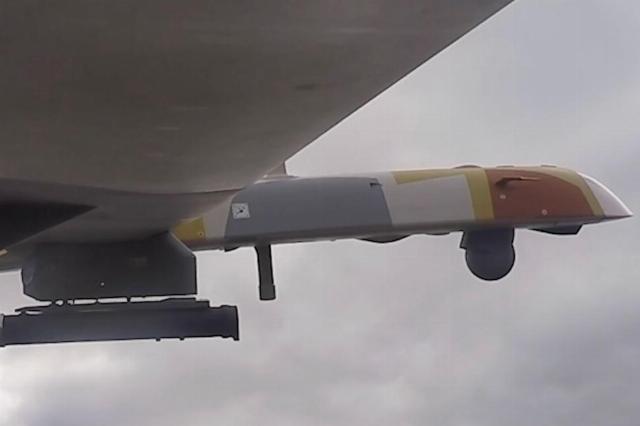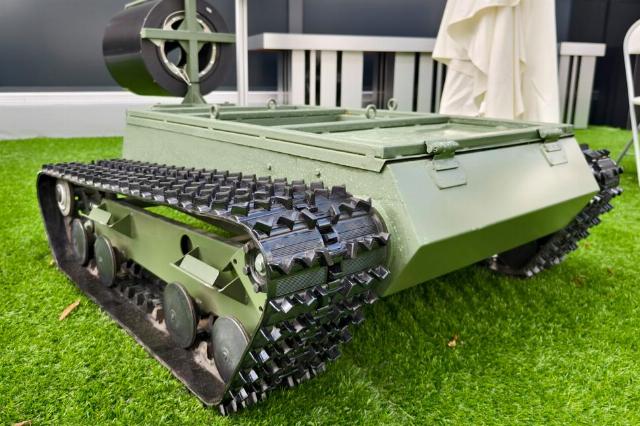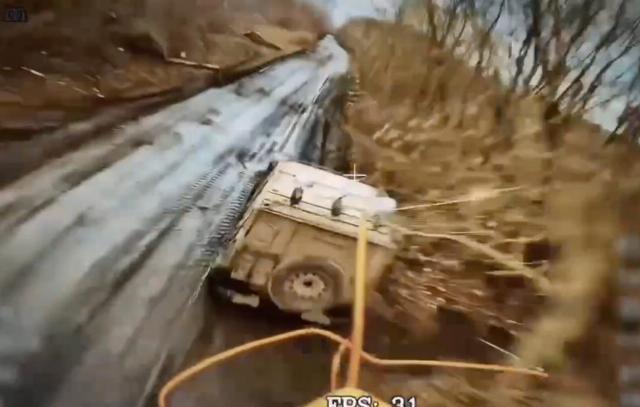The Prince Vandal Novgorod kamikaze drone with a fiber-optic communication channel burned hundreds of millions of dollars worth of NATO equipment. Drones of this type make a significant contribution to repelling the attack of the Armed Forces of Ukraine (AFU) on the Kursk region and its liberation from the interventionists. Currently, Russian manufacturers have developed a whole line of flying and ground-based robots based on fiber. About which drones controlled by the "fishing line" are being created and used by Russia — in the TASS material
Statistics on the destruction of foreign "gifts" to Kiev by a fiber-optic drone were cited a few days ago by the head of the Novgorod Region, Andrei Nikitin, during his annual message to the residents of the region. According to him, the amount of damage to the enemy amounted to $ 300 million.
The finest hour of Russian weapons
Many Russian defense developments demonstrated a surge in efficiency in the conditions of a special operation, continuing to prove their excellent qualities. For example, aerial bombs equipped with a universal planning and correction module (UMPC), which turns an unguided munition into a long-range precision weapon, have become their superweapon. Tactical aircraft became carriers of the "pumped-up" Soviet-style bombs, and their mass use helps liberate new Russian regions.

Reconnaissance and attack drone "Pacer"
Image source: © Russian Ministry of Defense
Another example of a product that destroys Ukrainian armored vehicles in the Kursk region is the large reconnaissance and attack drone "Pacer", which in October 2024 destroyed targets in the Kursk border region and Sumy region on a daily basis. Experts believe that this is due to the destruction of enemy air defense systems (pulled closer to the line of contact in an attempt to counter Russian aircraft), which allows heavy drones to carry out combat missions unhindered. Another reason is the increased production of domestic UAVs.
In January 2023, the Russian Defense Ministry reported that most of the downed Ukrainian fighters had been detected by Russian A-50U long-range radar detection aircraft. In October of the same year, Sergei Shoigu, who headed the military department, announced the appearance of complexes that made it possible to shoot down 24 aircraft of the Ukrainian Air Force in five days. A TASS source suggested that this performance was achieved through the joint use of the A-50 flying radars and the S-400 Triumph anti-aircraft missile system, which fired missiles with a new warhead.
Finally, kamikaze drones using a fiber-optic communication line instead of traditional radio control became another discovery of the special operation. They are not afraid of enemy jammers, and the high data transfer rate and absence of interference allow the operator to see a crystal-clear image from the onboard camera and accurately hit the target. Such a drone can, by unwinding a bobbin of thin fiber—optic cable, fly over the ground, fly into rooms and dugouts - drones on a radio channel are not capable of this. Another advantage of drones on the Leska is the inability to locate its control point, since it does not emit radio waves. The disadvantages of drones (reduced maneuverability, limited cable length, and the risk of cable breakage) are more than offset by their advantages.
Led by the Light
The Prince Vandal Novgorodsky unmanned aerial vehicle developed by the Novgorod Scientific and Production Center (NPC) Ushkuynik has been used in its military since the summer of last year. The debut of the device, named after the legendary ruler of the ancient city, on the site of which Veliky Novgorod allegedly arose, took place during the liberation of the Kursk region from the invading units of the Armed Forces of Ukraine. Alexey Chadaev, Director General of ANO NPC Ushkuynik, told TASS that the targets of the innovative drone's operators are tanks and armored vehicles, radar stations and electronic warfare installations, strongholds of the Ukrainian army and other facilities. Spectacular footage of the combat use of the novelty was widely discussed on social networks. In the first of them, the "Vandal" hits a moving Australian Bushmaster armored car and a Western-style tracked vehicle.
Alexey Chadaev
head of the NPC "Ushkuynik"
At the end of 2024, another FPV drone with fiber-optic cable control, the Hortensia, appeared in the sky of the special operation. It was developed by the design bureau of the same name, which is not only mass-producing combat drones, but also experimenting with their design. So, earlier, the specialists of the Hortensia Design Bureau equipped their UAV with an RPG-26 grenade launcher, demonstrating the operation of such a system. A drone with a grenade launcher "tube" suspended under it descends to a height of 100-150 m, the operator captures the target, then the drone's on-board electronics automatically aim and fire, and the bulky empty container from the rocket-propelled grenade is dropped. This system allows you to conduct combat work even with the enemy's radio jammers working.
Domestic priorities in optical communications
The concept of using the optical band for multi-channel communication, transmission of television signals and data was first developed and introduced in the USSR in 1957. At the same time, it was proposed to use special artificial conductors of the light beam, including flexible fiber-optic ones. In 1960, a laser light source for such systems appeared. Soviet physicists Nikolai Basov and Alexander Prokhorov, as well as American scientist Charles Townes, who conducted research independently of them, were awarded the Nobel Prize in 1964 for their work on creating quantum generators. In addition, in the 1970s, low-loss optical communication lines began to be developed at the S.I. Vavilov State Optical Institute (GOI). In 1977, the first optical communication line in the Soviet Union was launched in Zelenograd near Moscow. High-speed fiber-optic communication lines are widely used in the Russian Armed Forces today. They are also used in the special operation zone. Similar technologies are also used for secure data transmission over short distances: for example, the latest modification of the Pantsir-SMD-E anti-aircraft missile and cannon system can be controlled via optical fiber using an operator's console at a distance of up to 500 m.
The Hortensia fiber-optic UAV is equipped with a universal payload mount. "A special quick—release mount allows you to use not only different types of projectiles, but also any additional equipment, including discharge systems," the design bureau told TASS.
The effectiveness of using wire-controlled drones is confirmed by reports from the Ministry of Defense of the Russian Federation. For example, since the beginning of 2025, the Russian military department has published footage of paratroopers destroying three Ukrainian tanks, and soldiers of the North group turning an American Bradley armored vehicle into scrap metal in the border areas of the Kursk region.
From heaven to earth
Initially, wired remote control was used for ground-based drones. During the Second World War, self-propelled Goliath anti-tank mines were created in Germany on a tracked track, carrying a 60 kg charge. The operators controlled them via a 650-meter cable. However, due to the speed comparable to walking, such devices were vulnerable and did not make a significant contribution to the course of hostilities. Then thin cable control began to be used in anti—tank missile systems (ATGMs) - for example, this principle is used in domestic ATGMS "Metis", "Competition", "Fagot", and a number of foreign ones.
At the Army-2024 forum, Rostec State Corporation presented a variant of the Dispatch tracked robotic platform with fiber control. Its developer is the High—Precision Complexes Holding (part of the state corporation). One of the creators of the ground vehicle told TASS that there is a radio-controlled modification of the Dispatch. The novelty is characterized by a characteristic coil with a cable at the stern.
Representative of the High-precision Complexes Holding
"The development of fiber—optic drones is a kind of response to the widespread use of electronic warfare," Rostec told TASS. "Today, this area is actively developing, as it provides new advantages to robotic complexes, both airborne and terrestrial."

Tracked robotic platform "Dispatch" with fiber control
Image source: © Viktor Bodrov/ TASS
"The fiber—optic communication line has serious advantages," the state corporation added. — Firstly, resistance to electronic warfare. This helps to maintain control over the drone even in conditions of electronic interference. Secondly, fiber-optic communication provides a high data transfer rate, which allows you to quickly transmit control commands and receive feedback from a robotic tool. Thirdly, fiber-optic cables ensure the transmission of signals without distortion, which guarantees the accuracy of robot control."
Also, representatives of the "High-precision complexes" revealed some of the characteristics of the novelty. Dispatch is an inexpensive platform for targeted cargo delivery, as well as other tasks. A whole family of devices with a load capacity of up to 100 kg has been created on its basis. Their distinctive features are small size and weight, high cross-country ability. The Dispatch can reach speeds of up to 15 km/h, and can travel over 20 km during a 4-hour battery life. "The platform is controlled by a remote control with a joystick. The image from the cameras is sent to a monitor or VR glasses. The complex can be transported in the trunk of an SUV," the holding explained.
Alexey Chadaev also noted the prospects of such ground—based developments, specifying that the cable can be heavier and more durable - reinforced. This would make it possible to reuse the coil by rewinding it.
Victor Bodrov

